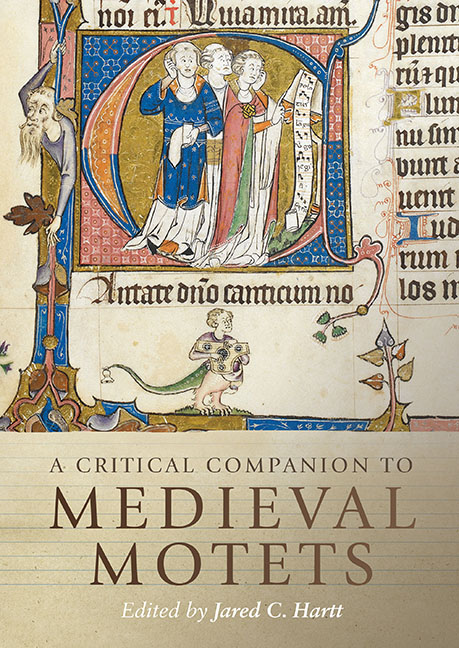Book contents
- Frontmatter
- Dedication
- Contents
- List of Figures
- List of Music Examples
- List of Tables
- List of Contributors
- Preface
- Acknowledgments
- Abbreviations
- Introduction: Approaching Medieval Motets
- 1 The Genre(s) of Medieval Motets
- 2 Origins and Interactions: Clausula, Motet, Conductus
- 3 Tracing the Tenor in Medieval Motets
- 4 Isorhythm
- 5 Notation
- 6 Thirteenth-Century Motet Functions: Views through the Lens of the Portare Motet Family
- 7 A Prism of its Time: Social Functions of the Motet in Fourteenth-Century France
- 8 Motets, Manuscript Culture, Mise-en-page
- 9 Clerics, Courtiers, and the Vernacular Two-Voice Motet: The Case of Fines amouretes / Fiat and the Roman de la poire
- 10 When Words Converge and Meanings Diverge: Counterexamples to Polytextuality in the Thirteenth-Century Mote
- 11 Motets in Chansonniers and the Other Culture of the French Thirteenth-Century Motet
- 12 Building a Motet around Quoted Material: Textual and Musical Structure in Motets Based on Monophonic Songs
- 13 The Duet Motet in England: Genre, Tonal Coherence, Reconstruction
- 14 Materia Matters: Reconstructing Colla/Bona
- 15 Machaut’s Motet 10 and its Interconnections
- 16 A Motet Conceived in Troubled Times: Machaut’s Motet 22
- 17 A Motet Ahead of its Time? The Curious Case of Portio nature/Ida capillorum
- Bibliography of Works Cited
- Select Glossary
- Index of Cited Motets
- General Index
- Studies in Medieval and Renaissance Music
8 - Motets, Manuscript Culture, Mise-en-page
Published online by Cambridge University Press: 21 October 2020
- Frontmatter
- Dedication
- Contents
- List of Figures
- List of Music Examples
- List of Tables
- List of Contributors
- Preface
- Acknowledgments
- Abbreviations
- Introduction: Approaching Medieval Motets
- 1 The Genre(s) of Medieval Motets
- 2 Origins and Interactions: Clausula, Motet, Conductus
- 3 Tracing the Tenor in Medieval Motets
- 4 Isorhythm
- 5 Notation
- 6 Thirteenth-Century Motet Functions: Views through the Lens of the Portare Motet Family
- 7 A Prism of its Time: Social Functions of the Motet in Fourteenth-Century France
- 8 Motets, Manuscript Culture, Mise-en-page
- 9 Clerics, Courtiers, and the Vernacular Two-Voice Motet: The Case of Fines amouretes / Fiat and the Roman de la poire
- 10 When Words Converge and Meanings Diverge: Counterexamples to Polytextuality in the Thirteenth-Century Mote
- 11 Motets in Chansonniers and the Other Culture of the French Thirteenth-Century Motet
- 12 Building a Motet around Quoted Material: Textual and Musical Structure in Motets Based on Monophonic Songs
- 13 The Duet Motet in England: Genre, Tonal Coherence, Reconstruction
- 14 Materia Matters: Reconstructing Colla/Bona
- 15 Machaut’s Motet 10 and its Interconnections
- 16 A Motet Conceived in Troubled Times: Machaut’s Motet 22
- 17 A Motet Ahead of its Time? The Curious Case of Portio nature/Ida capillorum
- Bibliography of Works Cited
- Select Glossary
- Index of Cited Motets
- General Index
- Studies in Medieval and Renaissance Music
Summary
WHEN, TWO CENTURIES AGO, the royal courtier turned music archivist Jean-Benjamin de Laborde stumbled upon some thirteenth-century motets, he mistook them for monophonic songs – songs, he claimed, that had short hymn melodies tagged on at their end. The reason for the hymn, Laborde surmised, was to show the original Latin melody from which the Old French song before it was derived. If he had actually compared the melodies, Laborde would have realized how different the Latin chants were from the Old French songs that preceded them. In fact, the French antiquarian had no idea that he was looking not at two separate melodies, but at two voices meant to sound together: the one an Old French melody or motetus, and the other a Latin chant fragment or tenor. Then again, Laborde's easy dismissal of the bilingual motet reflected the general attitude of his day towards counterpoint of the Middle Ages. As his contemporary Charles Burney wrote concerning organum of Gothic Antiquity (as he called the Middle Ages), such music would ‘neither please nor instruct the modern contrapuntist’. No wonder musical antiquarians of the eighteenth century had little interest in the medieval motet.
What had confused Laborde about the motets he had unwittingly uncovered was their miseen- page, their layout on the page. These polyphonic pieces are laid out in part format where one voice follows the other, rather than score format which presents simultaneously sung voices one on top of the other, a clearer visual representation of their mode of performance. The early motet's layout would continue to confound scholars until just over a century ago, when a professor of Latin philology by the name of Wilhelm Meyer finally linked the earlier Latin organum to its bilingual descendant the motet, thereby correctly identifying Laborde's ‘hymn incipits’ as tenors, the lower voice of a polyphonic motet. To be fair, the polyphonies of Adam de la Halle had been known for decades before Meyer's discovery, but this was because the rondeaux of Adam were laid out in the more transparent score format.
A few years after Meyer's serendipitous discovery, the first real scholar of the motet, a newly graduated doctor of history in his mid-twenties by the name of Friedrich Ludwig, set out to catalogue all extant sources containing medieval motets.
- Type
- Chapter
- Information
- A Critical Companion to Medieval Motets , pp. 175 - 192Publisher: Boydell & BrewerPrint publication year: 2018



